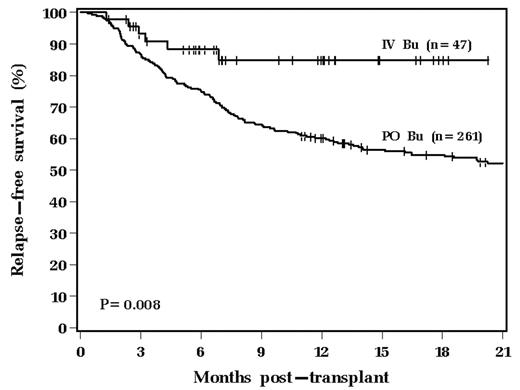Abstract
The efficacy of high-dose chemotherapy and ASCT for lymphomas is generally believed to be independent of the preparative regimen used, although toxicities may vary. Delayed toxicities after ASCT led us to investigate IV busulfan in older patients as a substitute for oral busulfan in a preparative regimen of busulfan/cyclophosphamide/etoposide (BuCyVP), based on data suggesting lower treatment-related mortality after ASCT with the IV formulation. We then queried whether other outcomes of ASCT for lymphomas were improved by substituting IV busulfan for oral busulfan. We retrospectively analyzed the outcomes of 308 patients over age 50 years who underwent ASCT for NHL (93%) or HL (7%) at the Cleveland Clinic from 1996 through 2/2006. Oral BuCyVP (“PO Bu”) was used in 261 patients and IV BuCyVP (“IV Bu”, 0.8 mg/kg IV x 14 doses given without monitoring or adjustment for serum Bu levels) in 47 patients. Differences in baseline characteristics were that the IV Bu group was more heterogeneous in the number of prior chemotherapy regimens (P=0.013), more often received chemotherapy for stem cell mobilization (P=0.026), had fewer NHL patients with a high-intermediate or high IPI score (P<0.001), and had fewer patients with stage III or IV disease (P=0.046). Follow up from ASCT was significantly longer in the PO Bu group (median 45.7 vs. 8.8 months). CD34+ cell doses and hematopoietic recovery were similar between groups.
Median overall survival was 43.6 months after ASCT with PO Bu but was not reached for the IV Bu group. Kaplan-Meier analysis demonstrated the unanticipated finding that IV Bu was associated with a lower rate of relapse (P=0.013), superior relapse-free survival (P=0.008), and a marginal improvement in overall survival (P=0.06).
Univariate Cox models identified the route of busulfan administration and disease status at ASCT as significant predictors of relapse. Age at transplant, the number of prior regimens, and LDH at transplant were significant predictors of mortality. Only the route of busulfan administration significantly predicted RFS in univariate analysis. In a multivariable model, the route of busulfan administration was the strongest predictor of RFS (P=0.043). Age was also predictive of RFS (P=0.047). These preliminary results suggest that replacing PO Bu with IV Bu is associated with a reduced relapse rate and improved RFS following ASCT for lymphoma. In contrast to other reports, we observed these improvements without targeting Bu dosage according to serum levels. Further study is necessary to confirm these findings and to ascertain whether IV Bu will favorably influence overall survival in this setting.
Disclosures: ESP Pharma provided funding.
Author notes
Corresponding author


This feature is available to Subscribers Only
Sign In or Create an Account Close Modal